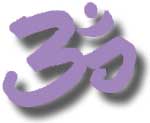Ashtanga Yoga
The Eight-Limbed Yoga
Page 2
1. The Five Yamas (continued)
Brahmacharya has two main meanings.
In the broad sense it means control of the senses or indriyas. More
specifically it refers to celibacy or chastity. Like all traditional
spiritual traditions, yoga advocates restraining from indulging in sensual
gratification.
One of the many reasons is that to practice the higher
limbs of ashtanga yoga - dharana, dhyana, samadhi - requires a tremendous
amount of energy or prana. This energy is built up through the practices
of yoga such as asanas, pranayama and japa but is dissipated during
sensual enjoyment. Of all the sensual activities, sex is the one that will
be the most depleting to the psychic and nervous system.
Most people
don't like to hear this but, like for the other yamas, everyone should
practice brahmacharya to the best of their ability. It is a fact that the
more people gratify their senses, the less energy they have and ability to
meditate on the absolute.

Asteya is non-stealing. This one is
pretty self explanatory. However it is good to bear in mind that there are
many subtle ways to appropriate what does not belong to us. As for the
other yamas, much self analysis will be necessary to catch the subtle
lower tendencies of our mind.
Aparigraha is non-covetousness. This
involves being happy and content with what we need and not always coveting
unnecessary and luxury items. To possess more than we need is a violation
of this precept. Note that aparigraha includes the notion of not accepting
gifts that would bind us to the giver.
2. The Five Niyamas
Saucha is purity. The deepest and
most subtle aspect of Saucha is purity of thoughts and feelings. But it
also means cleanliness of the body which for the hatha yogis includes the
internal cleansing practices known as kriyas.
A yogi must also keep his
surroundings (home, car workplace etc.) very tidy and clean. Purity is the
essence of the sattvo guna, of paramount importance to meditate
successfully.
Santosha is contentment. This is the
ability to recognize that although it is important to try to better our
environment and life situation through proper effort, the world around you
is never going to be perfect and absolutely to our liking. Therefore the
raja yogi should be happy with what he has and endeavor to do the best
with what he has got.
Tapas is austerity. The luxury and
comfort of our modern society, with all their advantages, make our mind
soft and weak. To strengthen ourselves physically and mentally we must
practice austerities. The highest tapas is meditation on God or the divine
Self. Daily practice of yogic disciplines is considered tapas. A very good
practice is fasting.
Swadhyaya literally means study of
the Self. The main practice is the study of the yogic scriptures but it
also includes japa (mantra repetition).
Not any yoga or spiritual book
qualifies as proper material for swadhyaya. For a vedantin the best
scriptures are the upanishads, the bhagavad gita and the brahma sutras.
Many other scriptures such as the puranas, the ramayana, the mahabharata
and many more.
Next come the books written by great mystics or masters
such as Swami Sivananda, Swami Vishnu-devananda or other saints from all
traditions.
Also suitable are books written about these masters -
biographies.
Ishwarapranidhana is surrender to
God's will and devotion. All ethical and moral precepts of yoga culminate
here.
3. Asana
Keeping in mind that the objective of raja yoga is to calm the mind
down, this is only possible if one has control of the physical body. Body
and mind are intimately connected and if the body is agitated the mind
will be actuated as a result. In order to meditate successfully one must
develop a very steady posture. Furthermore the posture must be kept still
for a long time and therefore it needs to be extremely
comfortable.
When the meditator is not able to control his mind, he is
advised to practice the asanas of hatha yoga in order to gain the needed
mastery.
4. Pranayama
The raja yoga theory tells us that prana is animating the mind. Very
much like the wind creates the motion of the leaves, prana creates the
motion of the mind which gives rise to the vrittis.
Air is the primary
physical medium of prana and breathing is our best method to gain control
over the prana. To meditate the practitioner should calm his breath down
until it is very shallow and even.
If this is not possible he should
practice the different pranayamas of hatha yoga.
|

